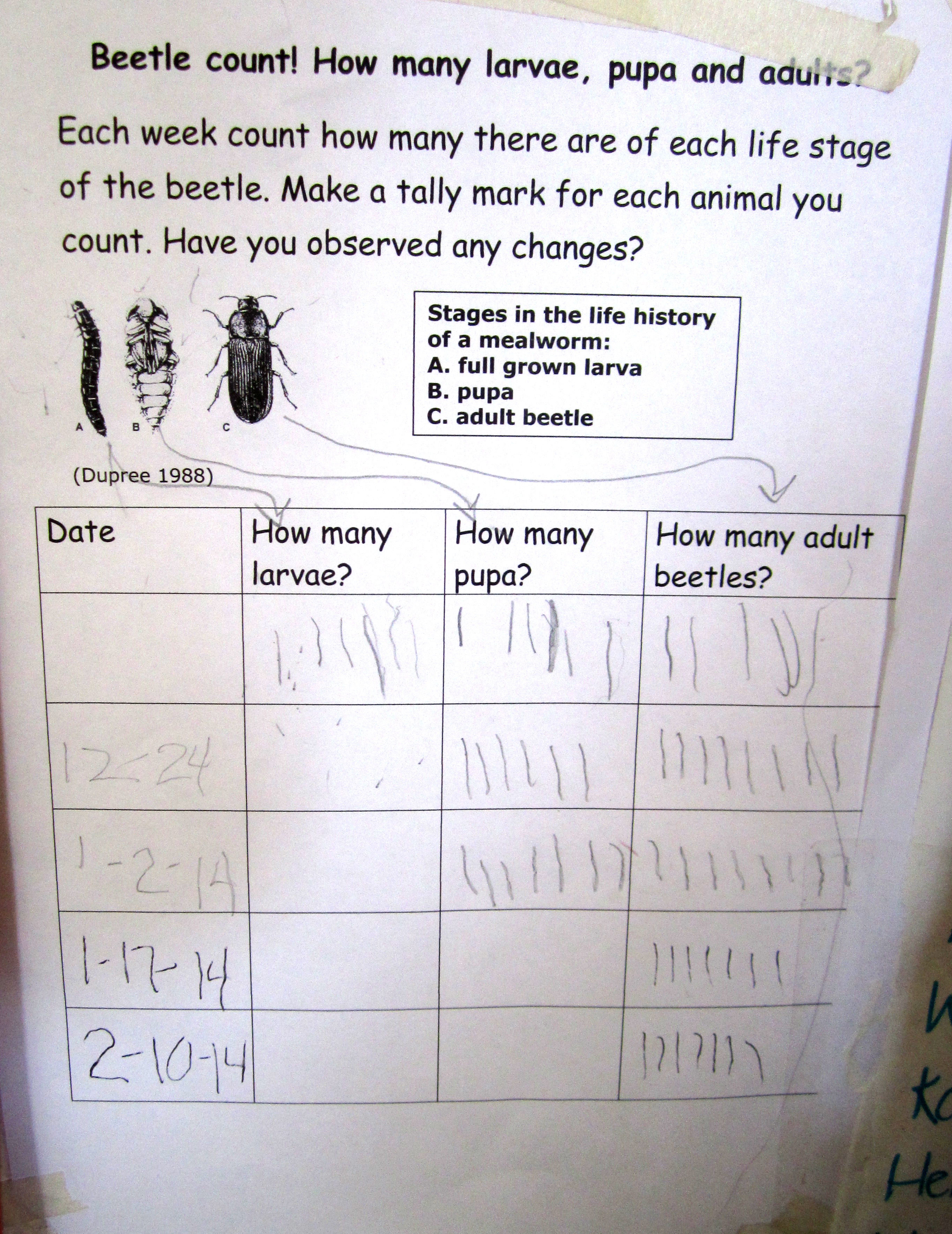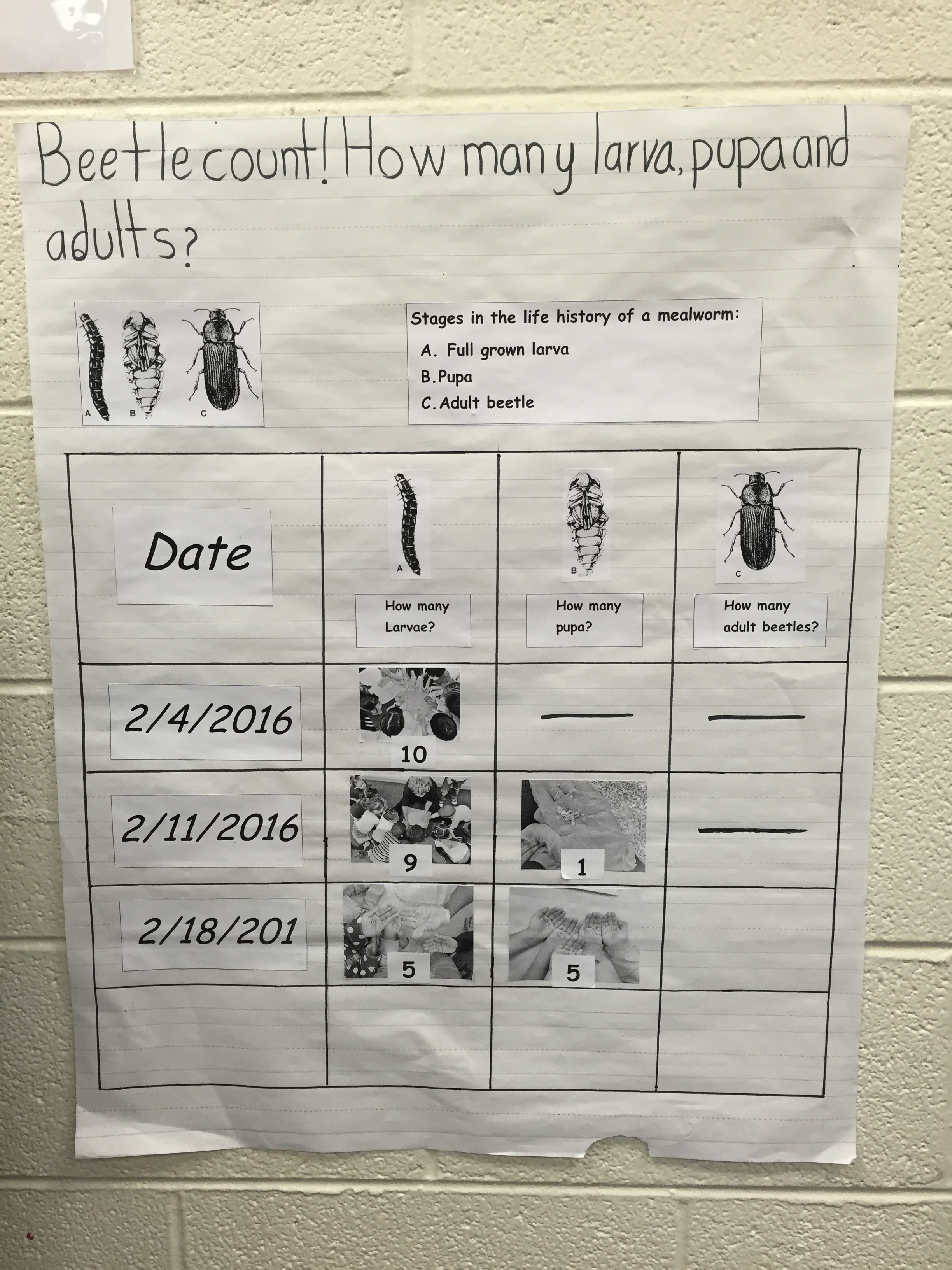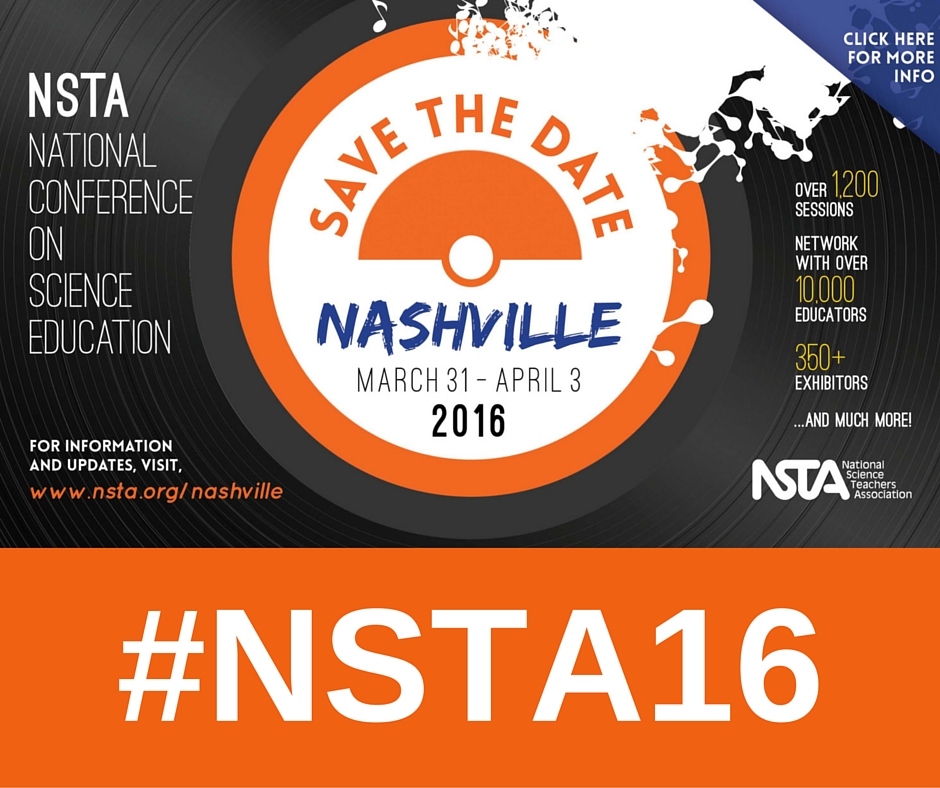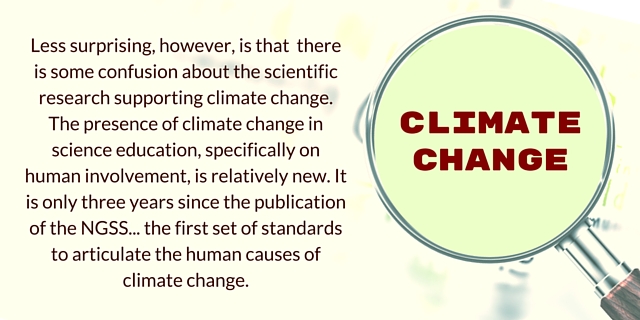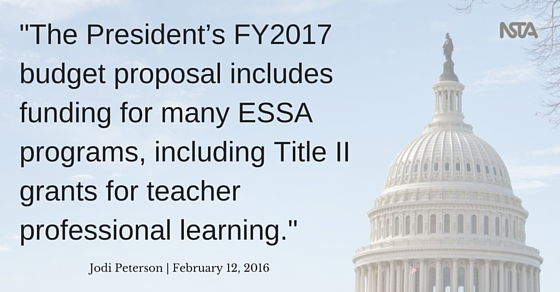Nine Ways Science Teachers Can Make the Most of #NSTA16 Nashville
By Carole Hayward
Posted on 2016-02-29
As you make your plans for NSTA’s National Conference in Nashville, take a look at this diverse array of events and opportunities designed to enrich your experience. (If you haven’t registered for the conference yet, what are you waiting for? Here’s information on how to register.)
NSTA’s conference offers many specialized opportunities for science educators. Find the ones that are right for you, and register for them today. Some events are free and others have a cost attached, but most require separate registration or tickets. Start planning now, so you don’t miss out. See you in Nashville!
|
Teaming Up for STEMBring a team to the conference, and NSTA will customize the conference experience for you and your team by engaging with you before, during, and after the conference to focus your STEM implementation efforts. Learn more! |
|
|
|
NGSS Train-the-Trainer WorkshopKick start the NGSS teacher training in your district with this March 30-31 workshop. Attendees will receive and use the e-book, Discover the NGSS: Primer and Unit Planner. Space is limited, so sign up today. (Also, join us for two free NGSS@NSTA events: the Forum and the Share-a-Thon.) |
|
The Northrop Grumman Foundation PLI Scholarship ProgramIf you are attending the conference, your school or district is within 200 miles of Nashville, and your student population has high needs, submit your application to be considered for a scholarship to a March 30 PLI. |
|
|
|
|
The mission of NSTA is to promote excellence and innovation in science teaching and learning for all.
Future NSTA Conferences
2016 National Conference
2016 STEM Forum & Expo
2016 Area Conferences
Follow NSTA
Reading aloud, asking questions and engaging in discussion
By Peggy Ashbrook
Posted on 2016-02-27
 “Do you remember Moomintroll?” my sister asked me recently. Moomintroll, a beloved Finnish character from the works of artist and author Tove Jansson, was introduced to us in an unusual picture book sent to our family by our aunt Kitty. The Book about Moomin, Mymble and Little My had a differently shaped hole cut in each page that provided a tantalizing peek at what came next in the story of Mommintroll’s journey— enough to provide information for a guess but not enough to be certain. Populated with Gaffsie and a fillyjonk, the book’s fantastic illustrations made the guessing more challenging than realistic pictures would have. And the text on each page explicitly invited the readers to guess by ending with a question, “What do YOU think happened then?”
“Do you remember Moomintroll?” my sister asked me recently. Moomintroll, a beloved Finnish character from the works of artist and author Tove Jansson, was introduced to us in an unusual picture book sent to our family by our aunt Kitty. The Book about Moomin, Mymble and Little My had a differently shaped hole cut in each page that provided a tantalizing peek at what came next in the story of Mommintroll’s journey— enough to provide information for a guess but not enough to be certain. Populated with Gaffsie and a fillyjonk, the book’s fantastic illustrations made the guessing more challenging than realistic pictures would have. And the text on each page explicitly invited the readers to guess by ending with a question, “What do YOU think happened then?”
Issuing an explicit invitation to think about what might happen means inviting a child to ask additional questions of herself—Could this happen? Could that happen? Might thus and so happen?—while she mulls over her answer. An adult asking a child a question, but not answering it, is leaving room for the child to actively think about the answer.
I often asked questions in my work as a preschool science teacher. At the beginning of the school year, some children politely sit and wait for the answer, not out of shyness but because they think that it is their job to wait for the adult to tell them the answer. How can we create an atmosphere where children will take on the responsibility of answering questions, and then asking them?
Reading books aloud in a dialogic reading style may be one way to inspire children to actively think about a question. Reading aloud continues to be an important part of building children’s oral language and vocabulary, listening comprehension, content knowledge, concepts of print, and alphabet knowledge and phonological awareness in elementary school (see “The Book Matters! Choosing Complex Narrative Texts to Support Literary Discussion” by Jessica L. Hoffman, William H. Teale, and Junko Yokota in Young Children). The authors urge us to choose books that have “rich and mature language—words and phrases that develop complex meaning and imagery,” “an artful, synergistic blending of text and illustration,” and “an engaging, complex plot”–all aspects that are strong in The Book about Moomin, Mymble and Little My.
 Another book with these characteristics and also lends itself to asking children to guess, or predict, is Fortunately by Remy Charlip. A delightful roller coaster of a book with a pattern of alternating “fortunate” and “unfortunate” pages, it is particularly well-suited to getting children started thinking about what happens next in a book, noticing patterns, and asking questions. Most of us need multiple opportunities to practice asking children to predict what will happen next in the story without adding our own comments. Be clear that you want the children to predict or guess, and that you will respect and accept all answers. Their answers do not have to agree with what you might say or with each other. At the end of the story ask the children if things turned out the way they predicted to encourage them to reflect on their guesses.
Another book with these characteristics and also lends itself to asking children to guess, or predict, is Fortunately by Remy Charlip. A delightful roller coaster of a book with a pattern of alternating “fortunate” and “unfortunate” pages, it is particularly well-suited to getting children started thinking about what happens next in a book, noticing patterns, and asking questions. Most of us need multiple opportunities to practice asking children to predict what will happen next in the story without adding our own comments. Be clear that you want the children to predict or guess, and that you will respect and accept all answers. Their answers do not have to agree with what you might say or with each other. At the end of the story ask the children if things turned out the way they predicted to encourage them to reflect on their guesses.
 I never predicted that Moomin and Mymble would be vacuumed up by a big Hemulen but it didn’t surprise me when the full-of-mischief and resourceful Little My helped them escape. Although not every book is designed to elicit questions and guesses with each turn of the page, every book offers a chance to predict at least once in the story. Try using the style of dialogic reading with your children the next time you read aloud to them.
I never predicted that Moomin and Mymble would be vacuumed up by a big Hemulen but it didn’t surprise me when the full-of-mischief and resourceful Little My helped them escape. Although not every book is designed to elicit questions and guesses with each turn of the page, every book offers a chance to predict at least once in the story. Try using the style of dialogic reading with your children the next time you read aloud to them.
Beetles before butterflies
By Peggy Ashbrook
Posted on 2016-02-25
 To prepare children to be close observers of the small animals that will be more easily seen in spring, I bring a container-habitat of beetles into the classroom during winter months. These Tenebrio beetles and larvae (widely known as “mealworms” although they are not worms) will live in the container, not colonize your classroom. Beetles in the classroom in a closed container, or on a tray, allows children to make hands-on observations of an insect as it changes from the baby form, a larva (like a caterpillar) to a pupa (like a chrysalis) to an adult beetle (like a butterfly). Observing more than one kind of small animal over time—isopods (roly-polies), gastropods (snails), insects, and others—introduces the diversity of animal life and provides multiple opportunities for children to build their understanding of living organisms.
To prepare children to be close observers of the small animals that will be more easily seen in spring, I bring a container-habitat of beetles into the classroom during winter months. These Tenebrio beetles and larvae (widely known as “mealworms” although they are not worms) will live in the container, not colonize your classroom. Beetles in the classroom in a closed container, or on a tray, allows children to make hands-on observations of an insect as it changes from the baby form, a larva (like a caterpillar) to a pupa (like a chrysalis) to an adult beetle (like a butterfly). Observing more than one kind of small animal over time—isopods (roly-polies), gastropods (snails), insects, and others—introduces the diversity of animal life and provides multiple opportunities for children to build their understanding of living organisms.
 Observing and caring for beetles also prepares children to observe and care for caterpillars in spring. Because children do not watch the larvae (baby beetles or caterpillars) continuously, they may not understand that a pupa or chrysalis is not a new animal but just a
Observing and caring for beetles also prepares children to observe and care for caterpillars in spring. Because children do not watch the larvae (baby beetles or caterpillars) continuously, they may not understand that a pupa or chrysalis is not a new animal but just a  new form of the baby insect that they have already seen. One way to support children’s developing understanding is to have them count the number of larvae in the Tenebrio beetle container-habitat every few days. How many babies can we find in the container? If you start with just 10 beetle larvae, children will be able to find all ten without losing interest. They can record their count (data) on a chart. Through regular observations and counts, children will notice when they find a pupa instead of all larvae. Their wonderings about this new form is an opportunity to wonder along with them and encourage them to draw to record their discovery.
new form of the baby insect that they have already seen. One way to support children’s developing understanding is to have them count the number of larvae in the Tenebrio beetle container-habitat every few days. How many babies can we find in the container? If you start with just 10 beetle larvae, children will be able to find all ten without losing interest. They can record their count (data) on a chart. Through regular observations and counts, children will notice when they find a pupa instead of all larvae. Their wonderings about this new form is an opportunity to wonder along with them and encourage them to draw to record their discovery.
Ms. Althea Pope, preschool teacher, made a poster size chart and added images of the children as they counted, further documentation that supports children’s view of themselves as practicing science. As children draw their observations of the insects over time they notice more and more details and become more comfortable with handling them.
I introduce “the babies” with a cooing voice, asking, “Does anyone want to see a baby beetle?” to help children feel comfortable. They know they are older than babies, and that we must be gentle with babies, so they respond with caretaking behavior rather than our other instinct of stepping on any small animal that moves. Some children will want to look closely but not hold the insects. Use small containers such as plastic baby food boxes so the beetles can be viewed closely. This also helps children with fine motor control difficulty hold them without accidently squishing them. Of course we never insist that a child get close to something that frightens them. We can offer them photographs or books to see what is so interesting to other children. A lamp can provide a bright light source in the classroom to help children with low vision see details.
While beetles may not have the poetic beauty of butterflies, they are more durable and children can easily handle them. They are sold as food for lizards and other pets at pet stores, in a refrigerated section.
 To prepare children to be close observers of the small animals that will be more easily seen in spring, I bring a container-habitat of beetles into the classroom during winter months. These Tenebrio beetles and larvae (widely known as “mealworms” although they are not worms) will live in the container, not colonize your classroom.
To prepare children to be close observers of the small animals that will be more easily seen in spring, I bring a container-habitat of beetles into the classroom during winter months. These Tenebrio beetles and larvae (widely known as “mealworms” although they are not worms) will live in the container, not colonize your classroom.
First Look: Hands on with the Pasco Wireless Temperature Sensor
By Martin Horejsi
Posted on 2016-02-21
The humble electronic thermometer is often the gateway technology into the world of digital data collection, and Pasco Scientific just made that tech much more affordable. And Bluetooth to boot! Whether measuring thermal motion at -40 degrees C which happens to be about the freezing point of Mercury, to 125 degrees C which happens to be the melting point of Iodine, the Pasco Wireless Temperature Sensor will do the job.


Using a stainless steel probe of 12cm in length and 5mm in diameter is topped with a boxy gasket-sealed plastic housing, the device is simple to use, familiar in design, and both large enough and small enough for most classroom activities.

What separates this particular probe from others on the market, and also a likely factor explaining its low price, is that the Pasco Wireless Temperature Sensor 1) uses a user-replacable CR2032 coin battery, 2) contains no on-board display with two indicator LEDs (one for on/off status and one for Bluetooth) providing all visible probe-side activity. And compared to other sensors in this form factor, there is no mistaking the blinking lights as they are quite conspicuous which is a good thing. And 3) the Pasco Wireless Temperature Sensor is just a radio transmitter beeping a short-range data point as often as 10 times a second. The technology for measuring temperature and popping off a radio blip is well dialed-in so the cost of materials to build a sensor such has this has come down drastically in the past few years. So all the heavy lifting (data visualization and manipulation) is done by the competing device that the Pasco Wireless Temperature Sensor is talking to.
Here’s the instruction manual for the sensor.

An note about the batteries: The three volt CR2032 cell that the Pasco Wireless Temperature Sensor uses is a very common size that can be purchased in most grocery stores. However, the cost of one battery might be the same as a half-dozen or more batteries when purchased in bulk. Pasco sells the batteries for a buck a piece when you by 10. When I wander the digital isles of Amazon.com and often can find name-brand coin cells for around that price as well.

The Internet of Things (IoT)
https://en.wikipedia.org/wiki/Internet_of_Things
The year 2013 was a big deal for IoT in that a perfect storm of technology intersected allowing us to vastly improve and increase our wired and wirelessly connected electronics. A leader in the IoT revolution was Bluetooth. Not the medieval 10th century king, but the wireless technology standard. And today the Pasco Wireless Temperature Sensor uses Version 4.0 Bluetooth also known as Low Energy Bluetooth, or BLE, or Bluetooth Smart. We are actually up to Bluetooth 4.2 as of this writing, but the security and extended packet lengths are not needed with temperature sensors.

A student, an 8th grade science aficionado to be more specific, took the Pasco Wireless Temperature Sensor for a spin on the river. Normally the weather would have the numbers in the single digits or even the thermodynamically absurd negative numbers, to this day was more like April or May than February in Montana.
Although the Pasco Wireless Temperature Sensor should survive brief total submersion in water due to it’s O-ring seals, only the metal probe should be immersed in the fluid to be measured. For this reason, I lightly sealed the probe’s head in a small zip-closure bag which also provided an attachment point to which a length of cord could connect the probe to the user.

After pairing the Pasco Wireless Temperature Sensor with an iPad Mini on shore, the student began moving away from dry land to test the range of the sensor. After a few repeated measurements, the Mini lost contact at about 33 meters, line of sight. I look forward to testing the distance with larger appliances including the iPad Pro.

The simplicity and intuitiveness of the Pasco Wireless Temperature Sensor makes using it, even for the first time, simple. Once on, the latest version of the SparkVue app is opened on almost any current device, and the Bluetooth button pushed. The Pasco Wireless Temperature Sensor pops up as a choice. Once selected, SparkVue is operated like it normally is with hardwired sensors.

At the end of the day on a Montana river in February, the sun was setting, the temperature dropping, and the margin of error between science fun and stupid was getting smaller.
In the end, this first adventure with the Pasco Wireless Temperature Sensor turned out well. The sensor preformed as advertised, and the temperatures were interesting and investigative, not life threatening which is always a good thing.
[youtube]https://youtu.be/ABGtDJLDrSI[/youtube]
The humble electronic thermometer is often the gateway technology into the world of digital data collection, and Pasco Scientific just made that tech much more affordable. And Bluetooth to boot!
Ideas and information from NSTA's February K-12 journals
By Mary Bigelow
Posted on 2016-02-21
This month, all three journals include Planning NGSS-Based Instruction: Where Do You Start? This article is another must-read for teachers who are looking for ideas to incorporate student questions and interests with the Next Generation Science Standards.
The lessons in all three journals include detailed graphic organizers showing how the authors would align the lesson to the NGSS. And if you’re interested in writing for an NSTA publication, the TST editor has some suggestions and encouragement!
A great benefit of NSTA is that members can access all of the journals online. So check out ideas that can be adapted for your students, regardless of grade level.
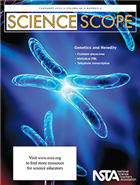
Science Scope – Genetics and Heredity
This month’s featured articles have ideas for incorporating crosscutting concepts and science practices with the content in genetics units.
- Using Local Street Trees to Teach the Concept of Common Ancestry has a lesson (available online) that goes beyond simply identifying trees to studying evolutionary relationships among species.
- From Mendel to Me: Constructing Genetics Knowledge Through Historical Problem-Based Learning provides a different context for traditional topics such as Punnett squares and
- Pass the DNA, Please uses a variation of the “telephone” game to simulate the idea of genetic transcription and translation and mutations.
- Controversial Environmental Issues Explored Through Interdisciplinary Perspectives: The Case of the Bald Eagle, the Botanical Garden, and the Airport has a real-life context for examining the relationships (sometimes controversial) between human needs and wildlife habitats.
- This month’s Guest Editorial Epigenetics: A New Science for Middle School—And Why You Should Teach It has a good overview of this growing field of science, along with resources for learning more about it yourself.
For more on the content that provides a context for these projects and strategies see the SciLinks websites Biodiversity, Differentiation, DNA, Genetic Traits, Genetics, Genotypes, Identifying Trees, Leaf Structure and Function, Mendel’s Laws, Mendelian Genetics, Mutations, Punnett Squares.
Continue for Science and Children and The Science Teacher.
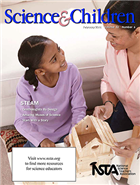 Science and Children – STEAM
Science and Children – STEAM
“Brainstorming solutions and creating scientific investigations can be enhanced through an innovative, creative, artistic approach.” (S&C editor).
- Mars Colony integrates role-playing into a simulated exploration of the planet (photographs included).
- Amazing Muses of Science shares the experience of students writing and performing a play that highlights contributions of women scientists.
- Kindergarten students, Ornithologists By Design, design, construct, and evaluate bird feeders in their own school-based “sanctuary.”
- Based on a book they read in class. Start With a Story has the story of students working with a zoo on interdisciplinary activities, such as designing animal habitats.
- In Luminous Lighting, students went beyond constructing simple circuits and applied what they know to creating wire sculptures that light up.
- Teaching Through Trade Books: The Science of Art has two 5E lessons in which students explore the science of crayons and how balloons such as those in parades are designed and engineered. For more on color, see Science 101: What’s Going on When You Mix Colors?
- The Early Years: Fostering Environmental Stewardship illustrates how students can communicate what they learn about nature through making and displaying collages. Methods and Strategies: Using Acorns to Generate an Entire Alphabet has ideas for enhancing language development through teachable moments during outdoor activities.
- Safety First: Safety Picks Up “STEAM” is another must-read article for elementary teachers to pro-actively design safe learning activities.
- Engineering Encounters: What Makes a Superhero “Super”? explores the concept of gravity.
For more on the content that provides a context for these projects and strategies see the SciLinks websites Birds, Colors, Current Electricity, Forces and Motion, Gases, Gravity, Matter, Habitats, States of Matter, Physical Properties of Matter, Planets, Space Exploration.
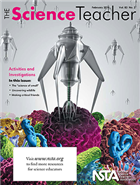 The Science Teacher – Activities and Investigations
The Science Teacher – Activities and Investigations
The featured articles have lots of ideas and resources for NGSS-aligned investigations in the life and physical sciences.
- Uncovering Wildlife includes a 5E lesson for turning the school grounds into an authentic research center using “cover boards” (photos included) to collect data on species that live there.
- Making Critical Friends describes a process for guiding pairs of students through the process of scientific argumentation around socioscientific issues such as energy sources, climate change, or GMOs.
- Shedding Light on the “Science of Small” has a 5E lesson in which students investigate titanium oxide nanoparticles as catalysts activated by UV radiation. The detailed article also includes photographs.
- A Virtuous Cycle introduces the Formative Assessment Design Cycle, a collaborative plan for designing common assessments. The cycle is illustrated in the context of a lesson in natural selection and the development of birds’ beaks.
- Finding Patterns describes an alternative to lectures and memorization for learning about how compounds are named, guiding students through pattern identification.
- Science 2.0: Mastering Scientific Practices With Technology recommends technology tools that support the NGSS science and engineering practices of Asking Questions and Defining Problems, Developing and Using Models, and Planning and Carrying Out Investigations.
- The Green Room: Conserving Tropical Rain Forests suggests resources for looking at conservation efforts and preserving biodiversity in these environments.
- Health Wise: Getting Past the Peak of Flu Season lists topics students could investigate related to the spread of diseases.
For more on the content that provides a context for these projects and strategies see the SciLinks websites Biodiversity, Bird Adaptations, Characteristics of Birds, Genetically Modified Crops, Habitat, Infectious Diseases, Naming Compounds, Nanotechnology, Rain Forests, Vaccinations, Viruses.
This month, all three journals include Planning NGSS-Based Instruction: Where Do You Start? This article is another must-read for teachers who are looking for ideas to incorporate student questions and interests with the Next Generation Science Standards.
Connecting with families
By Peggy Ashbrook
Posted on 2016-02-21
 I write a weekly note home to the families to accompany some photos for families to look at together and reflect on the week’s explorations with their preschool child. Sending a note home to families is part of an early childhood program’s way to strengthen the home-school connection to support families’ important work as part of the educational team. Science and Children editor Linda Froschaur cautions us to “Don’t Forget Families” and describes the benefits revealed by research about parent/family involvement, in her Editor’s Note in the February 2012 issue. Not surprisingly, student achievement, graduation rates and enrollment in post secondary education go up.
I write a weekly note home to the families to accompany some photos for families to look at together and reflect on the week’s explorations with their preschool child. Sending a note home to families is part of an early childhood program’s way to strengthen the home-school connection to support families’ important work as part of the educational team. Science and Children editor Linda Froschaur cautions us to “Don’t Forget Families” and describes the benefits revealed by research about parent/family involvement, in her Editor’s Note in the February 2012 issue. Not surprisingly, student achievement, graduation rates and enrollment in post secondary education go up.
The National Association for the Education of Young Children (NAEYC) recognizes the importance of connecting with families by making some articles from the journal, Young Children, free to all, such as, “What Parents Have to Teach Us About Their Dual Language Children” by Sara Michael-Luna in the November 2015 issue, Volume 70 No 5.
 Additional articles, such as, “The Gifts of the Stranger: Learning From Others’ Differences” by Susan Bernheimer and Elizabeth Jones in the September 2013 Young Children, support early childhood educators in embracing the increasing ethnic diversity of our population, or other changes in our educational community. A family-teacher book club is another idea described in an article in Young Children. If the length of a book is daunting, perhaps the discussion group could focus on articles from Science and Children.
Additional articles, such as, “The Gifts of the Stranger: Learning From Others’ Differences” by Susan Bernheimer and Elizabeth Jones in the September 2013 Young Children, support early childhood educators in embracing the increasing ethnic diversity of our population, or other changes in our educational community. A family-teacher book club is another idea described in an article in Young Children. If the length of a book is daunting, perhaps the discussion group could focus on articles from Science and Children.
NAEYC also has a section of its website called “For Families,” with articles about child development, math, music, science, writing and reading. Read my article (for families and educators), “Turn Any Walk into a Nature Walk,” for ideas on exploring nature on a walk anywhere, including around a city block. The bonding, listening and other skills and knowledge learned while singing with an adult are some of the same skills that allow children to build understanding of science content. Such learning begins in infancy as Cathy Fink and Marcy Marxer describe in “10 Ways Babies Learn When We Sing To Them!”
In “Families Learning Together: An elementary STEM-focused event brings students and families together” (Science and Children July 2015, Vol. 52 No. 9), Sarah MacDonald and Matthew Maurer describe how to use a Family STEM Night (Science, Technology, Engineering, Math) to show families how STEM can be fun and exciting for K–4 students. Through the use of hands-on science and engineering activities integrated with content from separate disciplines, families were given the opportunity to work alongside and support their children’s learning.

 In my experience with parents of preschoolers, seeing their child learning science content through hands-on experiences, and reflecting on them, makes an impression and supports their understanding that science learning is for everyone. If their 4-year-old can explore the electromagnetic spectrum (use flashlights to learn about light), then they will succeed, and should enroll, in science classes in high school.
In my experience with parents of preschoolers, seeing their child learning science content through hands-on experiences, and reflecting on them, makes an impression and supports their understanding that science learning is for everyone. If their 4-year-old can explore the electromagnetic spectrum (use flashlights to learn about light), then they will succeed, and should enroll, in science classes in high school.
 I write a weekly note home to the families to accompany some photos for families to look at together and reflect on the week’s explorations with their preschool child. Sending a note home to families is part of an early childhood program’s way to strengthen the home-school connection to support families’ important work as part of the educational team.
I write a weekly note home to the families to accompany some photos for families to look at together and reflect on the week’s explorations with their preschool child. Sending a note home to families is part of an early childhood program’s way to strengthen the home-school connection to support families’ important work as part of the educational team.
Teacher Professional Learning: Transforming Teacher Practice
By Guest Blogger
Posted on 2016-02-19
Several weeks ago the National Academies on Science (NAS) released a report that the National Science Teachers Association (NSTA) believes should be required reading for every school administrator.
Science Teachers’ Learning: Enhancing Opportunities, Creating Supportive Contexts focuses on enhancing teacher practice through professional learning situated within the context of their schools and districts. The report provides practical recommendations and lays out the supportive environment and professional learning experiences teachers need and which are critical to the enactment and application of the three-dimensional teaching and learning found in the K–12 Framework for Science Education and the Next Generation Science Standards.
In my January 25 blog post, I outlined a few of the key areas where it is critically important that teachers receive support as they move toward a new vision of teaching and learning, and provided suggestions on how NSTA can help.
This post will focus on the NAS report in the context of teacher resources and experiences, and why continued and sustained professional learning is so important. My thoughts and recommendations are drawn not only from the national academy report, but also from the Council of State Science Supervisors (CSSS) work on professional learning standards for science educators.
Teacher Resources and Experiences
As stated in the National Academy report, resources and experiences should be contextually relevant, focused on the specific students served by the school district, and as teachers implement these new resources and strategies, their practice should be informed by multiple data to guide future iteration and application as educators hone their knowledge and skills. Examples of data and content for analysis include student work, student surveys and interviews, teacher observations, review and discussion of pedagogical videos demonstrating pedagogical strategies in situ, etc. Ultimately, educators need repeated opportunities working with local district and school-based teams to plan, implement, and reflect upon these strategies as they enacted in their classrooms—critical tenants expressed within the report’s recommendations.
Teacher Professional Learning
In order for teachers to acquire this knowledge and skill, it is insufficient to merely have an understanding of science content knowledge (disciplinary core ideas of science). They need experience in the pedagogical practice of three-dimensional teaching, such as planning and conducting investigations, developing and using models, engaging in argument from evidence, and eliciting/interpreting student understanding through formative assessment to inform science instruction. An emphasis for all should include professional learning experiences in understanding engineering practices. Teachers need to engage firsthand in the ongoing learning and application of three-dimensional learning themselves beyond one-and-done, isolated experiences.
This is accomplished through the following strategies for blended professional learning that combine online and onsite experiences into multi-year, sequenced growth opportunities:
- Sustain personalized professional growth over time (long duration) to permit application, reflection, and iteration, and discussion with school-level educator teams over time and multiple years. Employ a variety of methods that promote educator collaboration within workshops, school-based teams, and in geographically dispersed digital networks. Develop roles for teacher growth to be recognized and serve as mentors or coaches to sustain professional learning and build local leadership capacity.
- Incorporate a degree of teacher autonomy in determining how the professional learning will occur, tapping the intrinsic motivation and personalized professional learning for individual teachers, and bounded within the mandates and initiatives of the school and district. To the degree appropriate, top-down one-size fits all approaches should not be the sole method of support. Differentiation for teachers drawing from their knowledge, experience, and skills treats them as professionals and builds collegial trust and ownership, as they adapt materials for their own use and local context rather than simply implementing for fidelity from external experts.
- Extend onsite professional learning with moderated online follow-up to enhance face-to-face experiences. Recognize and integrate online teacher activity when collaborating face-to-face and vice versa to create a coherent experience, avoiding a bolt-on, separate and isolated, click-next, home alone activity. Affordances in online networks provide immediacy, convenience, and access to colleagues, experts, and resources that may otherwise not be available. Examples include sharing how implemented strategies work with student artifacts and assessment data; reviewing, aggregating, and adapting instructional materials against established criteria (NSTA/Achieve EQUiP rubric), reviewing and discussing videos of pedagogical practice, etc.
The content of this post cannot do justice to the breadth and worth of strategies and scaffolding school and district leaders should consider as they alter the policy, time, structures, and resources science teachers need to growth across their professional career. I will highlight two recommendations in the report that clearly identify the role NSTA plays in the landscape of science education, that of partnerships and the use of educational technology to support local based efforts. The National Academy report states: “Professional learning can be enhanced through partnerships with teachers and their professional networks and…districts should consider the use of technology and online spaces/resources to support teacher learning in science.”
NSTA formally collaborates with over 180 districts and universities across the country, helping them implement their strategic goals and course offerings in support of NGSS and STEM, both at the in-service and pre-service levels, respectively. Our NSTA Learning Center platform may be configured to enhance local onsite efforts with private cohorts and administrator dashboards to help document teacher growth as they create and complete long term professional growth plans catering to their unique needs and district and school strategic plans.
If you’d like to learn more about the partnerships or products listed above, please feel free to contact me at abyers@nsta.org or 703-312-9294, or Flavio Mendez, Senior Director of the NSTA Learning Center
at fmendez@nsta.org or 703-312-9250.
 Al Byers, Ph.D., is the Associate Executive Director, Services for the National Science Teachers Association
Al Byers, Ph.D., is the Associate Executive Director, Services for the National Science Teachers Association
Editor’s Note
This post was updated on February 29, 2016, to include a link to the professional learning standards, published by CSSS.
The mission of NSTA is to promote excellence and innovation in science teaching and learning for all.
Future NSTA Conferences
2016 National Conference
NGSS Workshops
2016 STEM Forum & Expo
2016 Area Conferences
Follow NSTA
Several weeks ago the National Academies on Science (NAS) released a report that the National Science Teachers Association (NSTA) believes should be required reading for every school administrator.
Focus on STEM at #NSTA16 Nashville, March 31-April 3
By Korei Martin
Posted on 2016-02-16
Science, Technology, Engineering, and Math (STEM) is becoming a mainstay in schools around the world, and  the same will be true this spring at the NSTA National Conference in Nashville, March 31–April 3. There will be over 150 STEM-focused sessions, and three of the 13 featured speakers have detailed backgrounds in STEM and will be discussing STEM in their presentations. Our keynote speaker Grand Hank has the Grand Hank STEM Road Show Tour which exposes students across the United States to career opportunities in the area of STEM and energy. In 2012 he broke a Guinness World Record at our conference, and we expect no less excitement from him this year. Don’t miss Grand Hank’s keynote presentation, “Energize Science,” on March 31 in grand ballroom B/C at 9:15 AM.
the same will be true this spring at the NSTA National Conference in Nashville, March 31–April 3. There will be over 150 STEM-focused sessions, and three of the 13 featured speakers have detailed backgrounds in STEM and will be discussing STEM in their presentations. Our keynote speaker Grand Hank has the Grand Hank STEM Road Show Tour which exposes students across the United States to career opportunities in the area of STEM and energy. In 2012 he broke a Guinness World Record at our conference, and we expect no less excitement from him this year. Don’t miss Grand Hank’s keynote presentation, “Energize Science,” on March 31 in grand ballroom B/C at 9:15 AM.
 J. Wesley Hall, Director of the Tennessee STEM Innovation Network will be holding a panel titled, “It Takes a Village: A Panel on Partnerships from Multiple Perspectives.” This session emphasizes the need for schools and systems to reach out to the larger community for assistance when incorporating STEM into your curriculum or program. J. Wesley Hall will host a Q&A session with Aimee Kennedy, Vice President for Education, Philanthropy, and STEM Learning; Oliver “Buzz” Thomas, President, Great Schools Partnership; and James P. McIntyre, Jr., Superintendent, Knox County Schools. The featured panel will take place in room 102 A/B on March 31 2:00 PM.
J. Wesley Hall, Director of the Tennessee STEM Innovation Network will be holding a panel titled, “It Takes a Village: A Panel on Partnerships from Multiple Perspectives.” This session emphasizes the need for schools and systems to reach out to the larger community for assistance when incorporating STEM into your curriculum or program. J. Wesley Hall will host a Q&A session with Aimee Kennedy, Vice President for Education, Philanthropy, and STEM Learning; Oliver “Buzz” Thomas, President, Great Schools Partnership; and James P. McIntyre, Jr., Superintendent, Knox County Schools. The featured panel will take place in room 102 A/B on March 31 2:00 PM.
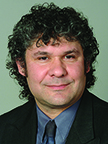 Jeff Goldstein’s “Arthur C. Clarke Institute for Space Education Lecture: Thoughts on Science Education, Science, and Personal Beliefs” will be centered on the vital role in the science and STEM classroom of inquiry- and evidence-based conceptual understanding at an emotional level and its connections to both science and one’s personal beliefs. The goal of the session is to provide a thought-provoking experience for all teachers of science and STEM. This session will take place on Saturday, April 2 at 2:00 PM in Grand Ballroom C2.
Jeff Goldstein’s “Arthur C. Clarke Institute for Space Education Lecture: Thoughts on Science Education, Science, and Personal Beliefs” will be centered on the vital role in the science and STEM classroom of inquiry- and evidence-based conceptual understanding at an emotional level and its connections to both science and one’s personal beliefs. The goal of the session is to provide a thought-provoking experience for all teachers of science and STEM. This session will take place on Saturday, April 2 at 2:00 PM in Grand Ballroom C2.
The NSTA National Conference will also provide educational field trips for attendees at an extra cost. The Welcome to My Classroom is a program sponsored by the International Advisory Board is hosting two different field trips focused on STEM. Both trips are centered on exposing international participants to STEM classrooms. One trip will take participants to Hattie Cotton STEM Magnet Elementary School and the other to Stratford STEM Magnet High School, both of which are located in Nashville Tennessee.
Once you’re signed up, consider coming as a team so we can give you and your district’s team members a personalized learning experience. If you come as a team, you’ll speed through an on-site express registration, network at an exclusive welcome reception, attend customized sessions that focus your STEM implementation efforts (including a district team planning session for teams to share their learning experiences at the conference and discuss how it may be implemented back in their district and keep your team on track). Learn more here (there is no extra charge for this concierge service, but it is limited to 100 teams).
No matter what kind of STEM experience you’re looking for, the NSTA National Conference will have what you need. Whether it’s a high energy hip hop session with Grand Hank or an example of a STEM classroom, there’s something for everyone!
The mission of NSTA is to promote excellence and innovation in science teaching and learning for all.
Future NSTA Conferences
2016 National Conference
2016 STEM Forum & Expo
2016 Area Conferences
Follow NSTA
Survey Reveals Challenges with Teaching Climate Change
By David Evans, NSTA Executive Director
Posted on 2016-02-12
This week, researchers at The Pennsylvania State University released the results of a nationwide survey of middle and high school science teachers on the teaching of climate change that tells us two things: first, we need to reach more teachers with quality resources about climate change and second, schools of education need to do a better job to prepare our future teachers in this area.
The survey results, published in Science Magazine on Feb 11 (Climate confusion among U.S. teachers), highlight challenges that surround the teaching of this important science subject. The survey was conducted among 5,000 middle and high school science teachers from 1,500 public schools across the country in the 2014-15 school year.
The survey found that 3 of 4 science teachers, (70% of middle-school science teachers and 87% of high school biology teachers) allocate at least an hour to discussing global warming in their formal lesson plans. By itself this is an interesting finding; why would biology class be the place teach climate science and what other important topic would be considered as being “taught with only one hour of instruction per year?
When asked to select a statement the closest one to own their views on global warming:
- 68% of teachers selected “global warming is caused mostly by human activities”
- 16% of teachers selected “global warming is caused mostly by natural changes in the environment”
- 11% selected “both”
- 3% of teachers selected “I don’t know”
- 2% of teachers selected “global warming is not happening”
But, the survey also found that
- 30% of teachers emphasize that recent global warming “is likely due to natural causes.”
- 31% said they “send explicitly contradictory messages, emphasizing both the scientific consensus that recent global warming is due to human activity and that many scientists believe recent increases in temperature are due to natural causes.”
- Only 30% of middle school and 45% of high school science teachers knew that the vast majority of scientists ( 81-100 percent) think global warming is caused primarily by humans.
I am encouraged that the majority of teachers (68%) identified with the statement “global warming is caused mostly by human activities.” The fact that more teachers know the correct science than know the percent of scientists holding that view is good news. Teachers are going top the literature to learn for themselves rather than depending on the views of “experts,” regardless of how numerous they might be. Less surprising, however, is that there is some confusion about the scientific research supporting climate change. The presence of climate change in science education, specifically on human involvement, is relatively new. It is only three years since the publication of the Next Generation Science Standards (NGSS) and implementation is just beginning. NGSS is the first set of standards to articulate the human causes of climate change. As the Penn State study notes, “advances in climate science and consolidation of scientific consensus have outpaced textbooks and teachers’ training.” The average science teacher has been out of school for about twenty years. It goes on to say that fewer than half of the teachers report receiving formal instruction in climate science in college, and two-third of teachers said they would be interested in continuing education “entirely focused on climate change.”
Our job as teachers is to prepare students to be educated consumers of science and make informed decisions about the world around us. This report makes it clear that science teachers need more and better professional development to build stronger content knowledge and confidence so they are better prepared to teach students this important science with its with its profound social implications. We know that teachers want to learn more about climate science– at our professional learning conferences last year, the sessions with climate scientists sharing their research with teachers was standing room only. NSTA also has multiple online resources, mostly free, that teachers can use to learn about climate change.
The 2012 National Research Council published A Framework for K-12 Science Education outlines a broad set of expectations for all K-12 students in science and engineering. The Framework, written by scientists and educators, provides a sound, evidence-based foundation for the NGSS that is grounded in both scientific and education research. The NGSS include the study of climate change supporting Earth and Space Science Performance Expectations in both middle school and high school. One of the relevant disciplinary core ideas is stated as:
ESS3.D: Global Climate Change Human activities, such as the release of greenhouse gases from burning fossil fuels, are major factors in the current rise in Earth’s mean surface temperature (global warming).
Adopting and implementing the NGSS is very much a work in progress. States are engaged in deliberative processes to revise their science standards and once they do, teachers need professional development to adjust their practices. The fact that many teachers themselves are not clear on climate science should not be a surprise; what is encouraging is the number of teachers who are learning the science and are trying to present it to their students, beyond the older standards.
Science teachers need our support as they continually improve their science content knowledge and their teaching skills. And science students and teachers need our support by adopting and implementing the best science standards – those that include the human causes of climate change. (Even if that science isn’t always popular with lawmakers and special interest groups.)
Dr. David L. Evans is the Executive Director of the National Science Teachers Association (NSTA). Reach him at devans@nsta.org or via Twitter @devans_NSTA.
The mission of NSTA is to promote excellence and innovation in science teaching and learning for all.
What can you do now to learn more about Climate Science? Join NSTA, in collaboration with the National Oceanic and Atmospheric Administration (NOAA), for the Climate Science in the Classroom virtual conference that will feature climate scientists and education specialists who will share both their knowledge about climate science as well as classroom-ready resources that educators can use with their students.
Follow NSTA
President Obama Releases FY2017 Budget
By Jodi Peterson
Posted on 2016-02-12
President Obama released the Administration’s FY2017 budget request this week, including mandatory spending of $4 billion for the opportunity to “give every student from preschool to high school the opportunity to learn hands-on computer science (CS).”
The President’s budget provides $69.4 billion in discretionary funding for the Department of Education, a 2 percent increase over the 2016 appropriation. The budget also includes $139.7 billion in new mandatory funding over the next decade. (Mandatory funding—not a popular concept with CH Republicans who want to shrink the government – requires that additional funding for proposed programs would be offset through revenue enhancements such as taxes, fees, cost reductions, and other levies proposed elsewhere in the budget.)
In addition to the proposed $4 billion in mandatory funds, the new Computer Science for All program would support provide $100 million in discretionary grants for a competitive state initiative to fund innovative strategies to provide high-quality instruction and other learning opportunities in computer science.
Funding Requests for Programs Authorized Under Every Student Succeeds Act (ESSA)
The request for Title I grants was $15.4 billion, an increase of $450 million above the enacted level. Many education advocates publicly worried that this amount would provide less funding for school improvement, however, since the new federal education law, the Every Student Succeeds Act (ESSA) requires states to set aside a portion of Title I funding for school improvement.
The request for ESSA Title II (Preparing, Training, and Recruiting High Quality Teachers and Principals Grants) is $2.25 billion. This major state formula grants program provides funds to each state to increase student achievement and close achievement gaps and to improve the effectiveness of teachers and school leaders. Funding for STEM education and educators is available under this grant.
The president requested $500 million for the new ESSA Title IV Part A block grant (Student Support and Academic Enrichment Grants, which also provides funding for STEM activities), considerably less than the $1.6 billion authorized in the new federal education law. The president’s budget proposal would allocate these grants to states by formula and then districts would have the option of competing for the funds. ESSA requires that the money would be allocated states and districts by formula.
The Administration requested $10 million in new funding for the national STEM Master Teacher Corps, one of the specific “national activities” authorized under ESSA.
Funding for 2017 was $180 million (up from $60 million to FY2016) for the Education Innovation and Research program, the successor to the Investing in Innovation (i3) program.
21st Century Community Learning Centers funding request was $1.0 billion (a loss of $166.7 million from FY 2016), to support locally-based out-of-school learning and enrichment activities.
In addition to the Computer Science For All program, the President’s budget this year includes requested funding for a number of programs not authorized under the ESSA, including
- A new RESPECT: Best Job in the World program that would make a $1 billion mandatory investment to support a nationwide effort to attract and retain effective teachers in high-need schools.
- $125 million for the proposed Teacher and Principal Pathways program for grants to institutions of higher education and nonprofit organizations to create or expand high-quality pathways into the teaching profession, particularly into high-needs schools and high-need subjects such as science, technology, engineering and math (STEM)
- $10 million for Teach to Lead grantsto build on the promising work at the Department’s “Teach to Lead” gatherings
- $120 million for new “Stronger Together” grants that would help districts implement voluntary, community-developed plans to promote integration.
- $80 million to help launch Next Generation High Schools “that will be laboratories for cutting-edge STEM teaching and learning.” Next Generation High Schools was in the president’s budget proposal last year as well.
National Science Foundation programs
The President’s request for the National Science Foundation would increase NSF’s discretionary spending by about $100 million, to $7.6 billion. The NSF’s Education and Human Resources Directorate funding is proposed at $952.86 million, an increase of $72.86 million or 8.3% over FY 2016. $53.99 million of this proposed increase is in the form of mandatory spending. The request for Advancing Informal Science Learning was $62.5 million (same as FY 2016, $7.5 million of this total would be mandatory funding.); STEM+Computer Science Partnerships Program request was $51.88 million (same as FY 2016, $30.64 million of this amount would be mandatory spending) and the President requested $60.89 million (same as FY 2016) for the Robert Noyce Teacher Scholarships.
Read the WH STEM Fact Sheet.
Jodi Peterson is Assistant Executive Director of Legislative Affairs for the National Science Teachers Association (NSTA) and Chair of the STEM Education Coalition. e-mail Peterson at jpeterson@nsta.org; follow her on Twitter at @stemedadvocate.
The mission of NSTA is to promote excellence and innovation in science teaching and learning for all.
Follow NSTA













